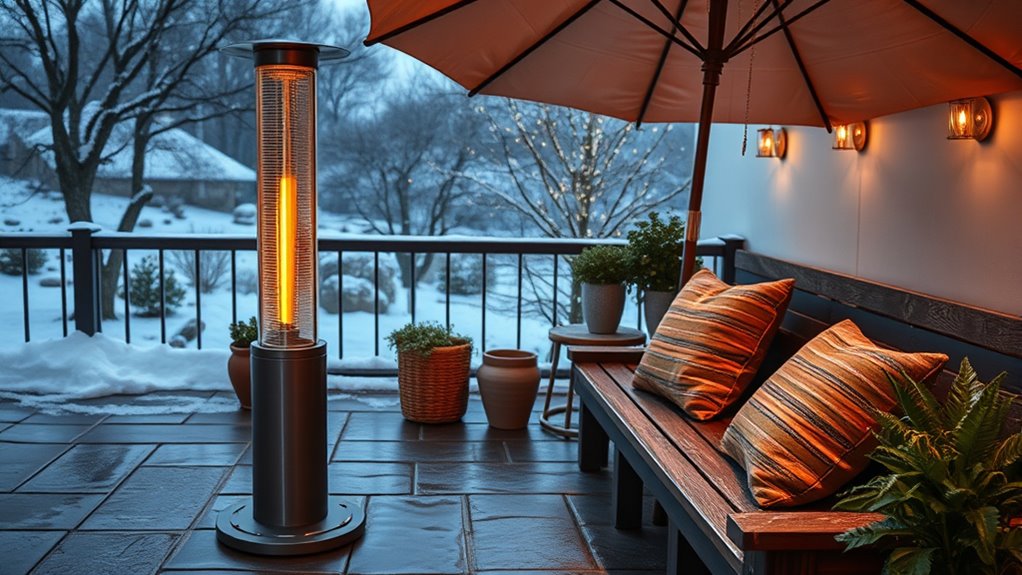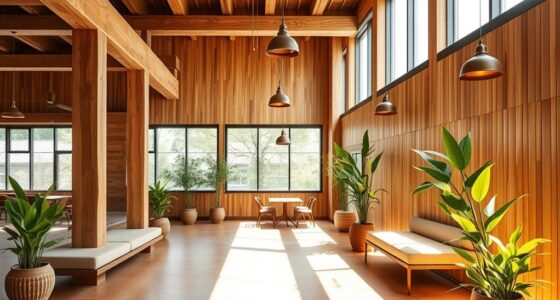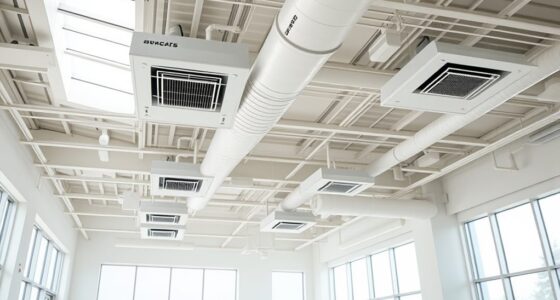To protect your outdoor heaters, choose weatherproof options like covers, sealant, and waterproof coatings suitable for your heater type. Store portable models in a shed or garage during harsh weather, and always keep heaters on stable surfaces away from flammable materials. Regular maintenance, inspections, and proper placement will extend their life. Continue exploring how to maximize outdoor comfort and safety with effective weatherproofing tips and techniques.
Key Takeaways
- Choose the right outdoor heater (electric, propane, infrared) based on space size, climate, and usage needs.
- Follow safety guidelines: proper placement, stable surfaces, and keeping flammable materials away.
- Use weatherproof covers and sealants to protect heaters and furniture from rain, snow, and moisture.
- Regularly inspect and maintain heaters to prevent damage, rust, and ensure safe operation.
- Incorporate weather-resistant textiles and accessories to enhance comfort and prolong outdoor space durability.
Types of Outdoor Heaters and Their Benefits
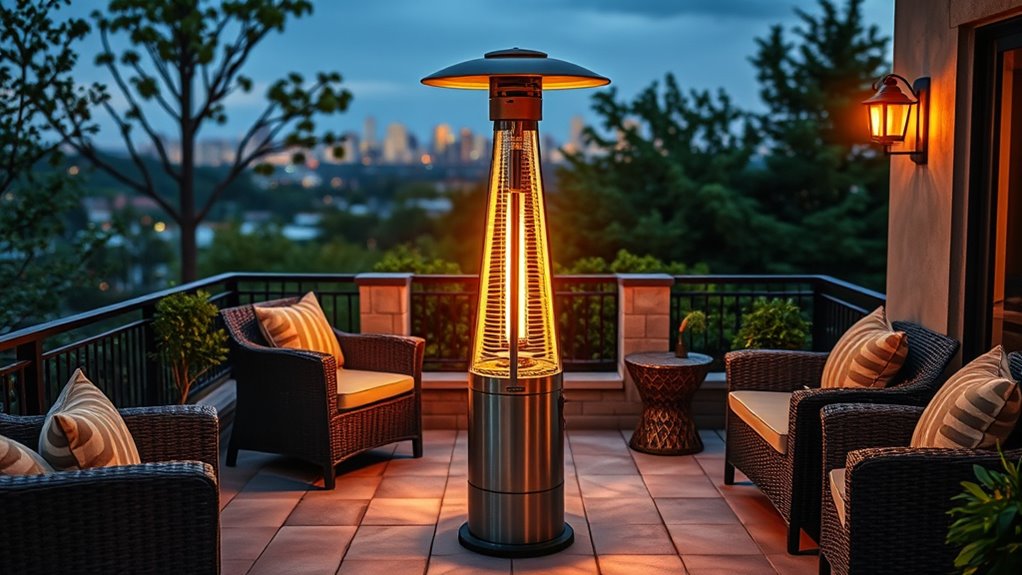
When choosing outdoor heaters, understanding the different types and their benefits can help you make an informed decision. Propane heaters are portable and quick to heat, making them perfect for outdoor gatherings and flexible setups. Electric heaters are energy-efficient and easy to operate, ideal if you want a low-maintenance option that heats small to medium spaces. Infrared heaters provide instant warmth and focus heat directly on people or objects, reducing wasted energy. Gas heaters, whether propane or natural gas, generate significant heat and are suitable for larger outdoor areas. Each type offers unique advantages, from portability and convenience to efficiency and power. Knowing these differences guarantees you select a heater that fits your space, usage, and climate needs effectively. Proper installation and maintenance ensure safety and optimal performance of your outdoor heating system.
Choosing the Right Outdoor Heater for Your Space

Choosing the right outdoor heater depends on your specific space, how you plan to use it, and your climate. If you have a small patio, a compact electric heater might be enough to keep the area warm. For larger spaces or open-air setups, a propane or natural gas heater provides more heat and longer-lasting warmth. Consider if you’ll be using the heater frequently or just occasionally—this influences whether a permanent or portable option suits you best. Think about safety features, ease of use, and energy efficiency. In colder climates, high-capacity heaters ensure comfort, while milder areas might only require gentle heat sources. Taking these factors into account helps you select a heater that fits your needs, keeps you comfortable, and is practical for your outdoor environment.
Essential Weatherproofing Materials and Tools

To effectively protect your outdoor spaces from the elements, you need to be familiar with essential weatherproofing materials and tools. These items guarantee your outdoor heater and furniture stay in top condition. First, weatherproof sealants are vital for sealing gaps and cracks, preventing water intrusion. Second, waterproof covers safeguard heaters and furniture when not in use. Third, weather-resistant paints and coatings add a protective layer against moisture and UV rays. Fourth, using appropriate storage practices ensures that your equipment remains in good shape during off-season periods. Finally, tools like caulking guns, brushes, and squeegees help you apply these materials precisely and efficiently. Using these materials and tools correctly extends the lifespan of your outdoor setup, keeps it looking good, and guarantees comfort during every season. Being prepared with these essentials makes weatherproofing straightforward and effective.
Protecting Your Outdoor Heater From the Elements

Protecting your outdoor heater from the elements is essential to guarantee it functions safely and lasts longer. Start by covering your heater with a weatherproof cover when it’s not in use, especially during rain, snow, or heavy wind. Make sure the cover fits snugly to prevent moisture from seeping in and causing rust or damage. If your heater is portable, store it in a sheltered area like a shed or garage during harsh weather. For built-in models, install protective awnings or overhangs to shield them from direct exposure. Regularly inspect for signs of wear or damage to the protective coverings, and replace them as needed. Taking these steps helps safeguard your investment and guarantees your heater remains reliable for seasons to come. Additionally, choosing high-quality precious metals dealer options and securing proper storage can further enhance the longevity of your outdoor heating equipment.
Maintenance Tips to Extend the Life of Your Heater
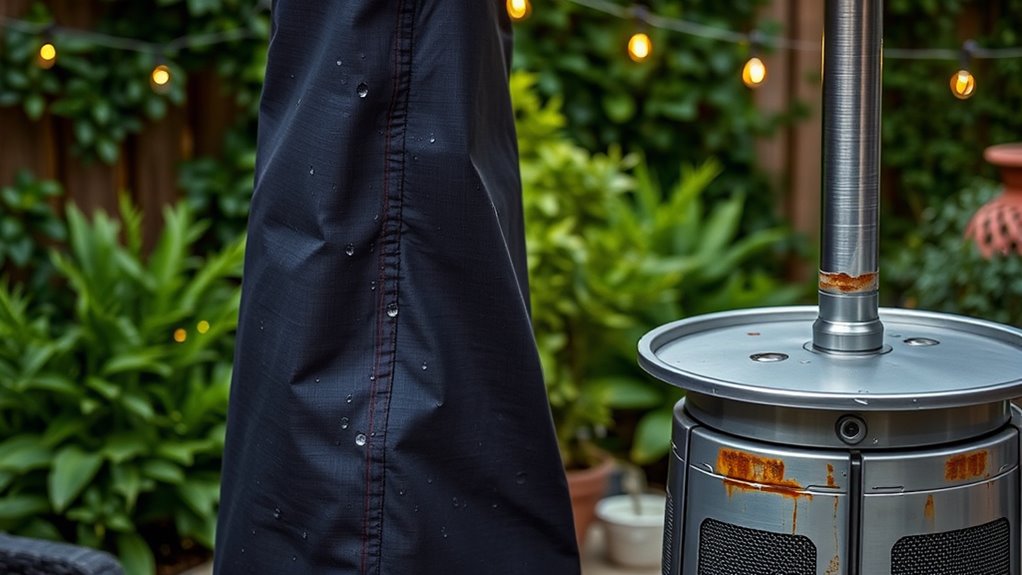
Regular maintenance is key to keeping your outdoor heater in ideal condition and extending its lifespan. Consistent care prevents corrosion, keeps components functioning properly, and ensures safety. Here are some essential tips:
- Clean the heater regularly, wiping down surfaces and removing debris to prevent buildup.
- Check for corrosion or rust and treat affected areas with rust-resistant paint or sealant.
- Inspect and replace any damaged or worn parts, such as igniters or thermocouples.
- Cover the heater when not in use, especially during harsh weather, to protect it from moisture and debris.
- Monitoring the contrast ratio can help ensure your projector maintains high image quality over time.
Creating a Cozy Atmosphere With Proper Arrangement

To create a cozy outdoor space, carefully position your heaters where they’ll provide the most warmth without crowding your area. Add ambient lighting to set a relaxed mood and make sure your seating is comfortable and inviting. When you combine these elements, you’ll craft an inviting atmosphere perfect for chilly evenings. Consider incorporating weatherproofing to ensure your setup remains comfortable and functional regardless of unexpected weather changes.
Strategic Heater Placement
Strategic heater placement is essential for creating a warm and inviting outdoor space. Proper positioning guarantees even heat distribution and maximizes comfort. To achieve this, consider these key points:
- Place heaters near seating areas to keep guests warm without needing to move around.
- Position heaters against windbreaks or walls to prevent heat loss and improve efficiency.
- Avoid placing heaters under overhangs or low-hanging branches that can block heat flow.
- Use multiple heaters for larger spaces to ensure uniform warmth without cold spots.
- Regular maintenance and proper placement can prevent issues like overheating or inefficiency, ensuring long-term performance.
Ambient Lighting Tips
Creating a cozy outdoor space depends heavily on how you arrange your ambient lighting. Start by layering different types of lights—use string lights for a soft, warm glow, hanging them overhead or along fences. Incorporate lanterns or portable LED candles to create intimate pools of light on tables or walkways. Dimmers are your friends; they let you adjust brightness to match the mood. Avoid harsh, bright lights that can feel uninviting. Instead, focus on diffused lighting that spreads evenly and softly. Position lights strategically to highlight key areas like seating zones or focal points, ensuring no dark corners. Regularly check your lighting setup to ensure proper placement and functioning, just as regularly inspecting tires for cracks or deformities helps maintain bike safety. With thoughtful placement, your outdoor space becomes inviting, warm, and perfect for relaxing evenings.
Comfortable Seating Setup
A well-arranged seating area instantly transforms your outdoor space into a cozy retreat. To achieve this, consider the following:
- Position seats around your outdoor heater to maximize warmth and comfort.
- Use furniture that invites relaxation, like cushioned chairs or a sectional sofa.
- Create conversation zones by grouping chairs closely, encouraging interaction.
- Incorporate side tables for drinks and snacks, making the space functional and inviting.
- Select weatherproof textiles to withstand outdoor elements and maintain comfort. Weatherproof textiles
Ensure your arrangement promotes easy movement and visibility, so everyone feels included. Add weather-resistant cushions and throws for extra comfort and warmth. Use planters or outdoor rugs to define the space and add a touch of style. With thoughtful placement, your outdoor setup becomes a perfect spot to unwind, regardless of the weather.
Safety Precautions When Using Outdoor Heaters
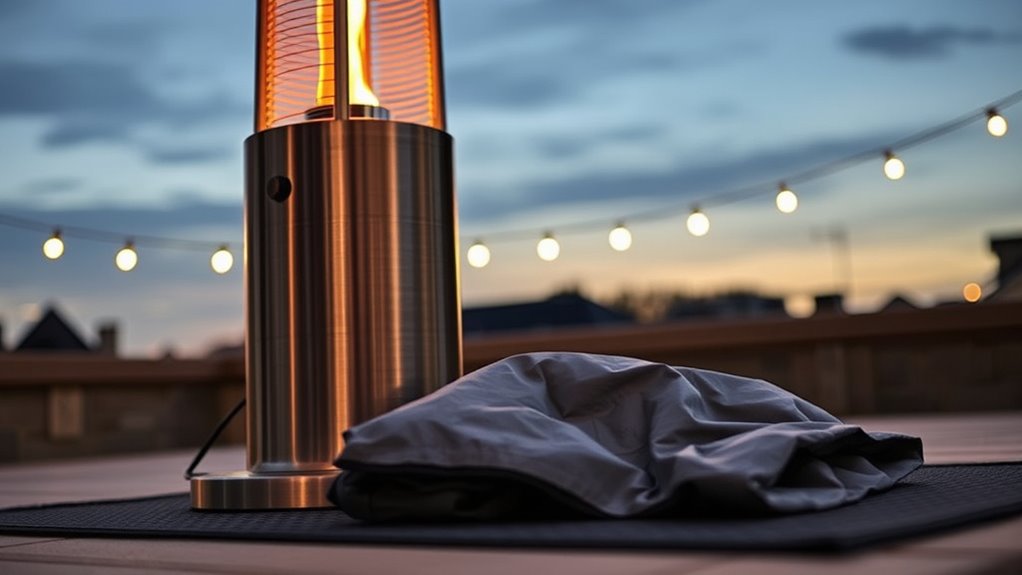
Using outdoor heaters safely is essential to prevent accidents and injuries. Always read the manufacturer’s instructions before use, and guarantee the heater is properly installed on a stable, level surface. Keep a safe distance from flammable materials like paper, fabric, or wooden furniture. Never leave a heater unattended while it’s on, especially if children or pets are nearby. Regularly inspect your heater for damage, such as frayed cords or leaks, and repair or replace faulty units immediately. Use outdoor heaters only outdoors or in well-ventilated areas to prevent carbon monoxide buildup. When turning off the heater, wait for it to cool down completely before handling or storing it. Following these precautions helps you enjoy outdoor heat safely and reduces the risk of accidents. Additionally, understanding weatherproofing techniques can help protect your outdoor heating equipment from environmental damage.
Budget-Friendly Weatherproofing Solutions

Keeping your outdoor space protected doesn’t have to break the bank. There are simple, budget-friendly weatherproofing options that work effectively. First, use heavy-duty outdoor tarps or plastic sheeting to cover furniture and equipment when not in use. Second, seal gaps around doors and windows with weatherstripping or caulk to prevent drafts and moisture intrusion. Third, add inexpensive sandbags or weighted objects to secure outdoor covers against wind. Fourth, consider DIY solutions like applying waterproof spray to cushions or furniture for added protection. Additionally, understanding spiritual energy can remind us to create a balanced and harmonious environment both indoors and outdoors. These strategies are affordable, easy to implement, and can considerably extend the life of your outdoor space, ensuring you enjoy it year-round without overspending.
Frequently Asked Questions
How Energy-Efficient Are Different Types of Outdoor Heaters?
When considering how energy-efficient different outdoor heaters are, you should look at their fuel sources and technology. Electric heaters tend to be more efficient because they convert almost all electricity into heat, while propane or gas heaters may waste some energy through emissions. Infrared heaters are often the most efficient because they directly heat objects and people rather than the air. Your choice depends on your specific needs and energy priorities.
Can Outdoor Heaters Be Used Safely on Wooden Decks?
You might find yourself curious about whether outdoor heaters can safely grace your wooden deck. While it’s tempting to think they’re a cozy addition, you should approach with care. Use heaters specifically designed for outdoor use, keep them at a safe distance from wood surfaces, and avoid leaving them unattended. With proper precautions, you can enjoy warmth without risking damage, making your outdoor space both inviting and safe.
What Are the Environmental Impacts of Outdoor Heating Options?
When considering outdoor heating options, you might wonder about their environmental impacts. You should know that many heaters, especially gas-powered ones, emit greenhouse gases that contribute to climate change. Electric heaters are cleaner but can still increase your energy consumption and carbon footprint if the electricity comes from fossil fuels. To minimize environmental effects, opt for energy-efficient models, use timers, and consider renewable energy sources whenever possible.
How Do I Prevent Pests From Nesting Near My Outdoor Heater?
To prevent pests from nesting near your outdoor heater, you need to eliminate their attractants, create barriers, and maintain cleanliness. Remove debris, trim overgrown plants, and store food away from the area. Use physical barriers like mesh screens, and regularly inspect the space for signs of pests. By staying proactive, you’ll discourage pests from nesting, keep your outdoor space safe, and guarantee your heater functions efficiently without unwanted visitors.
Are There Portable Weatherproofing Solutions for Travel or Camping?
Yes, you can find portable weatherproofing solutions perfect for travel or camping. Look for compact, lightweight covers made from durable, water-resistant materials like nylon or polyester. These covers easily slip over your gear or equipment, protecting it from rain, wind, and dirt. You might also consider silicone sealants or weatherproof spray coatings for added protection. Always choose solutions that are easy to pack and quick to set up, ensuring your outdoor adventures stay hassle-free.
Conclusion
Think of your outdoor heater as a trusted companion, weathering storms and welcoming cozy nights. With the right choices and proper protection, you’ll keep it thriving through seasons, turning your patio into a sanctuary that endures. Just like a sturdy tree standing tall against the wind, your dedication to weatherproofing and maintenance guarantees your outdoor space remains inviting and warm, no matter what Mother Nature throws your way.
